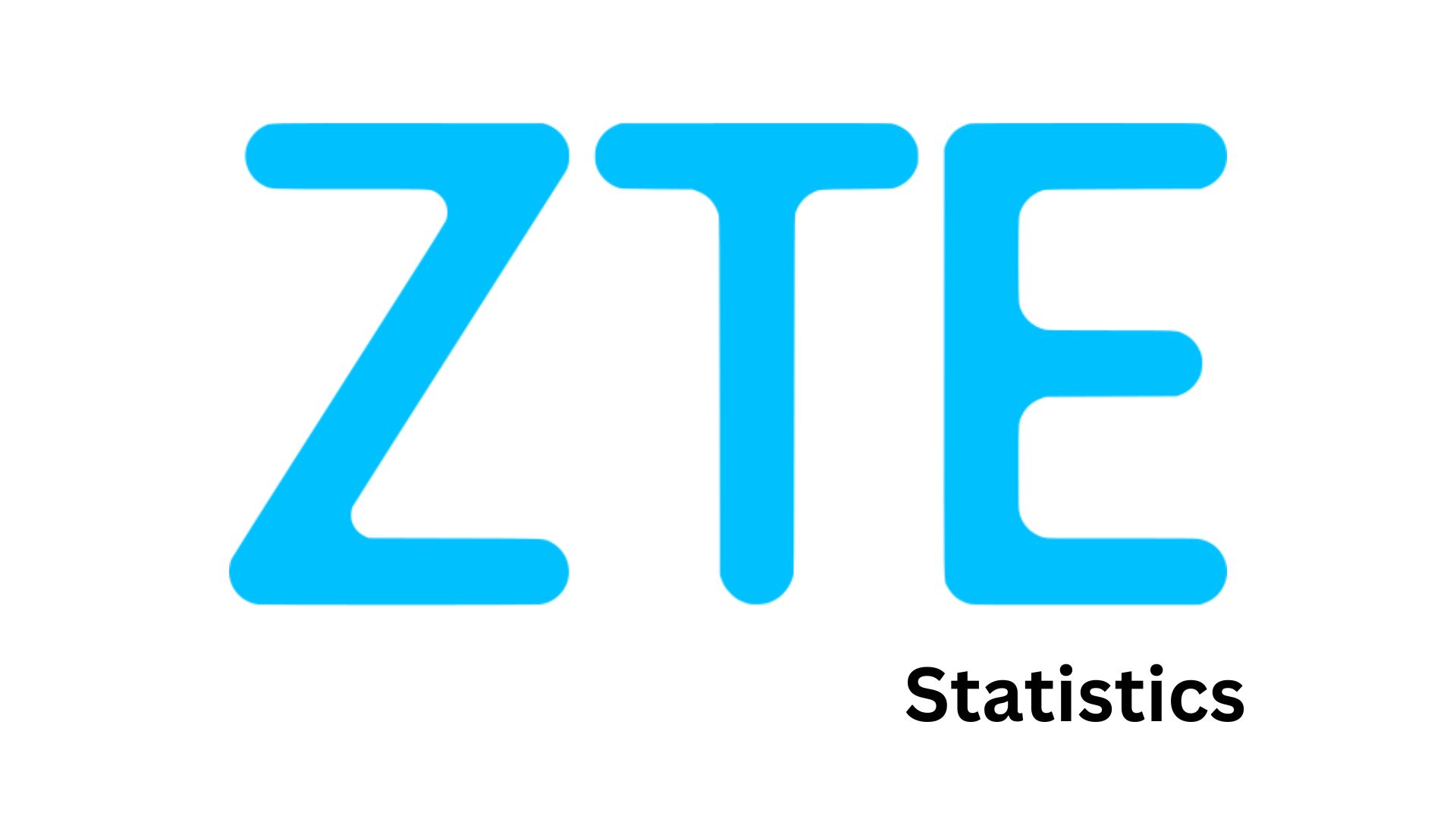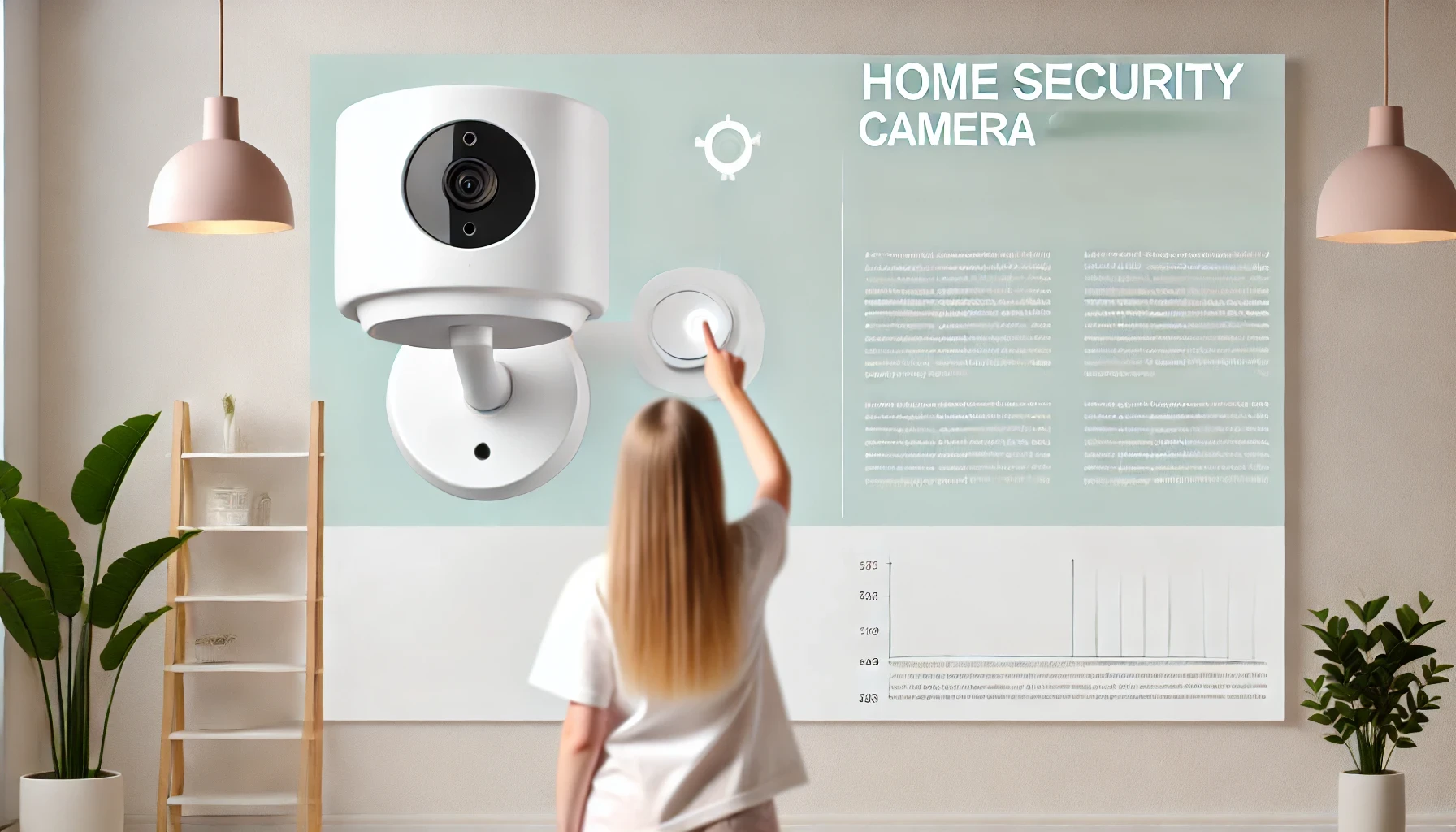Battery Usage Statistics By Market Size, Types Of Devices and Demographics
Updated · Aug 27, 2024
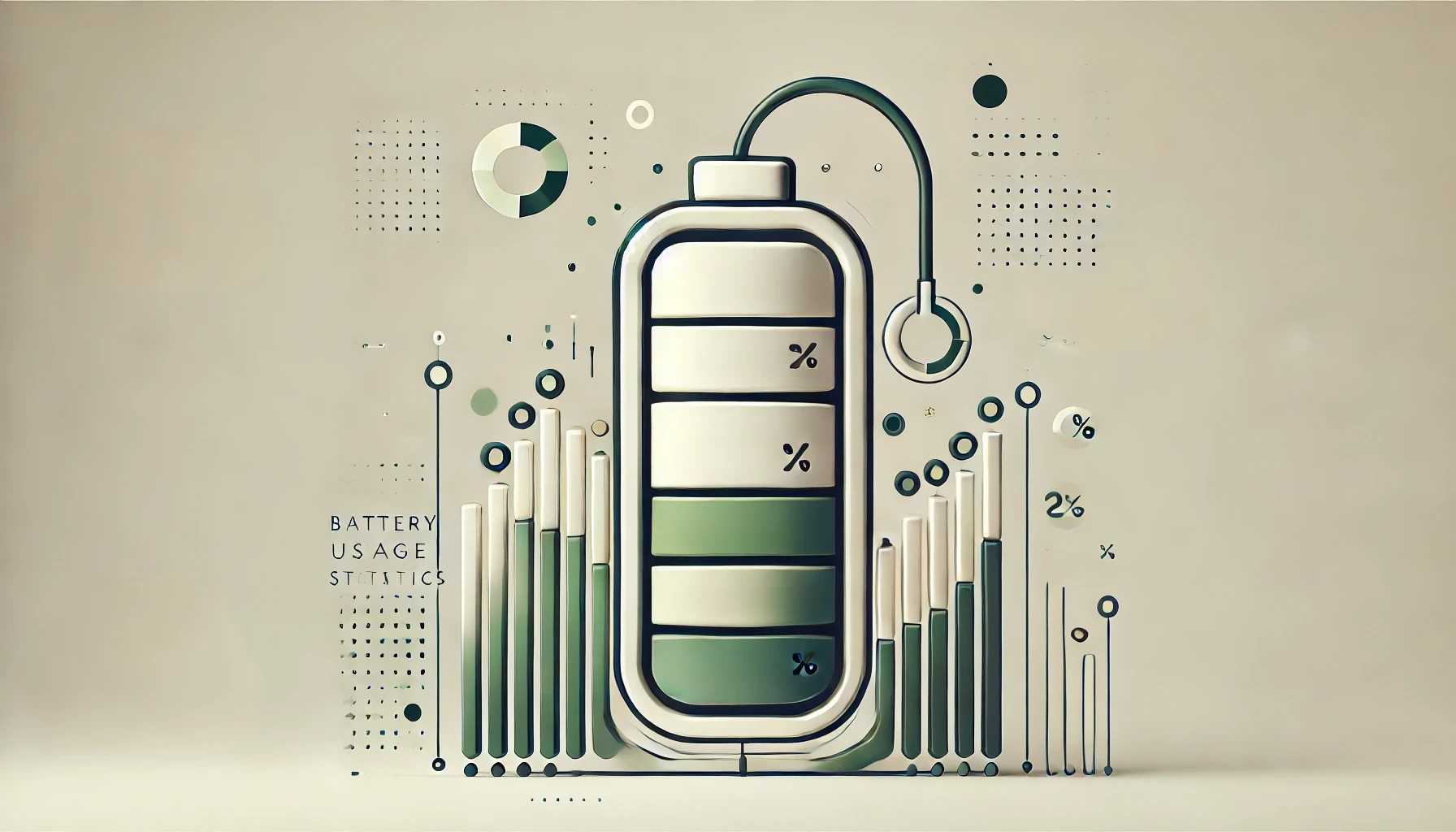
Table of Contents
Introduction
Battery Usage Statistics: The statistics on battery usage provide valuable information on how much power various devices consume. This information is important for manufacturers who want to improve energy efficiency, and for users who want to better manage their device’s battery life. By analyzing battery usage data, we can identify trends such as average battery lifespan, power consumption levels, and the impact of different apps on battery life. Understanding device performance is crucial for consumers and developers, especially in the context of smartphones, laptops, and wearable technology.
As the demand for portable electronics increases, accurate information on battery usage becomes essential for creating better and more durable batteries that can last longer, ultimately improving the user experience. Additionally, knowing battery usage statistics can help users make informed decisions about how they use and maintain their devices, ensuring that they get the most out of their batteries.
Editor’s Choice
- Battery Life of Flagship Smartphones: Modern flagship smartphones often provide over 24 hours of battery life. For instance, the iPhone 14 Pro Max can last around 29 hours during video playback, while the Samsung Galaxy S23 Ultra offers about 28 hours.
- Impact of Gaming: High-performance activities like gaming can reduce battery life by 30-40%, bringing usage time down to approximately 16-18 hours.
- Wearable Technology Battery Life: The Apple Watch Series 8 offers up to 18 hours of battery life, while the Fitbit Charge 5 can last up to 7 days. These improvements reflect a 20% increase in battery performance over the past two years.
- Energy Efficiency Improvements: Energy efficiency has increased due to advancements in low-power processors and optimized software, leading to a 15-20% reduction in power consumption.
- Effects of Software Updates: Major software updates can reduce battery life by up to 15%. For example, iOS 16.4 reportedly decreased battery efficiency by 10-12% on older iPhone models, reducing their battery life from 24 hours to approximately 21-22 hours.
- Innovations in Battery Efficiency: AI-driven battery management and eco-friendly materials have improved energy efficiency by 25%. The Google Pixel 7’s adaptive battery, for instance, extends usage time by up to 2 hours, reaching 26-27 hours.
Type Of Devices And Their Battery Usage
Nowadays, batteries are one of the most crucial aspects of electronic gadgets, and they are used in almost every portable electronic gadget. From Drones, mobile phones, and tablets to automobile EVs, one common electronic element is the battery. The current battery market is estimated to be around USD 114.2 billion. This market is growing with the increase in EVs and the expansion of portable electronics and wearable electronic gadgets.
Mobile Phone
- 65%of the people of this country are going through discomfort. Due to the drainage of the batteries
- 72% of the people start getting nervous and anxious when the battery percent drops to 20%
- For 45% of users, the smartphone is the first and the last thing they use when they start or end their day.
- 85% of people use their mobile phones when they are getting charged, and this leads to the drainage of battery
- 58% are likely to replace their smartphones for better battery performance.
- Mobile phones are most likely to have a range of 3000 to 5000mah battery capacity.
- The average smartphone user uses their device for 10 to 20 hours, depending on the task ( calling, browsing, gaming).
- The screen time is expected to be 7 to 9 hours in a day
- The battery degradation rate is about 20% battery capacity loss after 500 charge cycle
Tablet
- According to statistics on laptop battery usage in 2024, contemporary machines have batteries that can hold between 40 and 100 Wh, allowing for 4 to 10 hours of use between charges. To be more precise, ultrabooks usually last up to 10 hours, whereas high-performance laptops—like those used for demanding work or gaming—usually last 4–6 hours.
- Many laptops now have fast charging capabilities, allowing them to achieve 50% charge in 30 minutes or less. The increasing requirement for devices that provide dependable, ongoing performance necessitates these developments, particularly given the growing desire for efficiency and portability.
- The capacity of the battery of a tablet ranges from 40wh to 100wh
- The average usage time of a tablet which drains the battery is 8 to 14 for mixed-use like browsing, gaming and streaming
- The battery backup provided is very good. It can last up to several days or a week on a single charge.
Laptop
- According to statistics on laptop batteries from 2024, contemporary gadgets have batteries that can hold a charge for four to ten hours, with a capacity ranging from 40 to 100 Wh. Ultrabooks can last up to 10 hours on average, whereas high-performance laptops, such as gaming laptops, can only last 4–6 hours. Many laptops can charge to 50% capacity in less than 30 minutes thanks to fast charging technologies. As the need for dependable, portable, and effective devices increases, these developments are essential.
- The battery capacity of a laptop varies from 40wh to 100wh
- The average usage time of a laptop is 7 to 8 hours a day, and it varies for different tasks like streaming, editing, gaming, etc.
- A laptop lithium battery usually takes 2 to 4 hours for a fully charged battery.
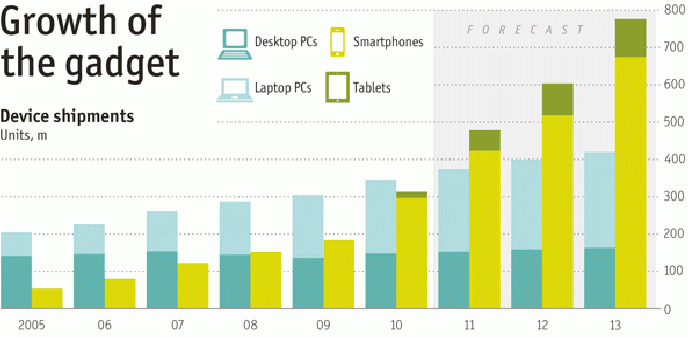
(Source: researchgate.net)
Factors Affecting Battery Usage
Battery usage statistics indicate that the cycle life of a battery, particularly lithium-ion types, is a crucial aspect. Cycle life refers to the number of times a battery can be charged and discharged before it reaches a predefined end-of-life capacity. Various factors can impact this cycle life.
Temperature
Temperature significantly influences a battery’s life cycle by affecting the chemical reactions within lithium batteries. The ideal operating temperature for these batteries is around 27°C. Deviating from this temperature—whether higher or lower—can lead to a loss in battery capacity.
Current Flow
Current flow also plays a key role. Higher currents typically generate more heat and put additional stress on the battery, which can diminish its life cycle.
Depth of Discharge (DoD)/Voltage Windows
It’s generally recommended not to charge batteries from 0% to 100% state of charge (SoC), as doing so can negatively impact cycle life. Instead, charging should occur within a range, such as from 25% to 85% SoC. This can be managed either by the user or by built-in features in the battery management system.
Regular battery service and maintenance are essential for the reliability of Uninterruptible Power Supplies (UPS) and for accurate battery usage statistics. Routine checks, including voltage assessment, load testing, and monitoring, can help track an annual decline in battery life of about 3-5%. Performing preventive maintenance every 6 to 12 months can extend battery life by up to 20% and prevent issues like loose connections and corrosion. Even “maintenance-free” batteries require attention to avoid a 10-15% increase in resistance and up to a 30% reduction in protection. Proper maintenance not only ensures accurate battery usage statistics but also facilitates scheduled replacements, preventing unexpected downtime or power loss.

(Source: top10electrical.blogspot.com)
Average Battery Life Statistics
In today’s world, batteries play a critical role in powering everything from personal devices to electric vehicles (EVs). In the automotive industry, the rise of EVs has underscored the importance of batteries, with many countries establishing lithium charging stations to support this growing sector. Leading manufacturers of mobile phones, laptops, tablets, and wearable devices are increasingly focusing on enhancing battery life, which is key to building customer loyalty.
Mobile Phone Battery Life
Several top-tier smartphones have impressive battery capacities:
- Asus ROG Phone 8 Pro: 5500mAh
- OnePlus 12R: 5500mAh
- Asus ROG Phone 7 Ultimate: 6000mAh
- Asus Zenfone 11 Ultra: 5500mAh
- OnePlus 12: 5400mAh
- Samsung Galaxy S24 Ultra: 5000mAh
- Samsung Galaxy S24 Plus: 4900mAh
- iPhone 15 Pro Max: 4441mAh
It’s generally advised that a battery’s charge not be depleted below 20% and not charged to 100% frequently, as this can prolong its lifespan. Over time, lithium-ion batteries, like those in smartphones, typically lose about 20% of their capacity after a year or two of regular use.
Laptop Battery Life
Modern laptops offer battery life that ranges from 4 to 10 hours on a single charge. Ultrabooks are particularly popular among professionals due to their lightweight design and extended battery life, often lasting up to 10 hours per day. However, after approximately 500 charge cycles, most laptop batteries lose about 20% of their original capacity, leading to decreased performance. Many of today’s laptops are equipped with fast-charging technology, allowing them to reach 50% charge in just 30 minutes.
Electric Vehicles (EVs)
The automotive battery market, valued at USD 94.5 billion in 2024, is projected to grow to USD 237.28 billion by 2029, with a compound annual growth rate (CAGR) of 20.53% during this period. The European Union has set a goal to reduce greenhouse gas emissions by 55% by 2030, while China aims for 25% of all new car sales to be electric by 2025. As the EV market continues to expand rapidly, the demand for automotive batteries is expected to surge, presenting significant opportunities for companies in this sector.
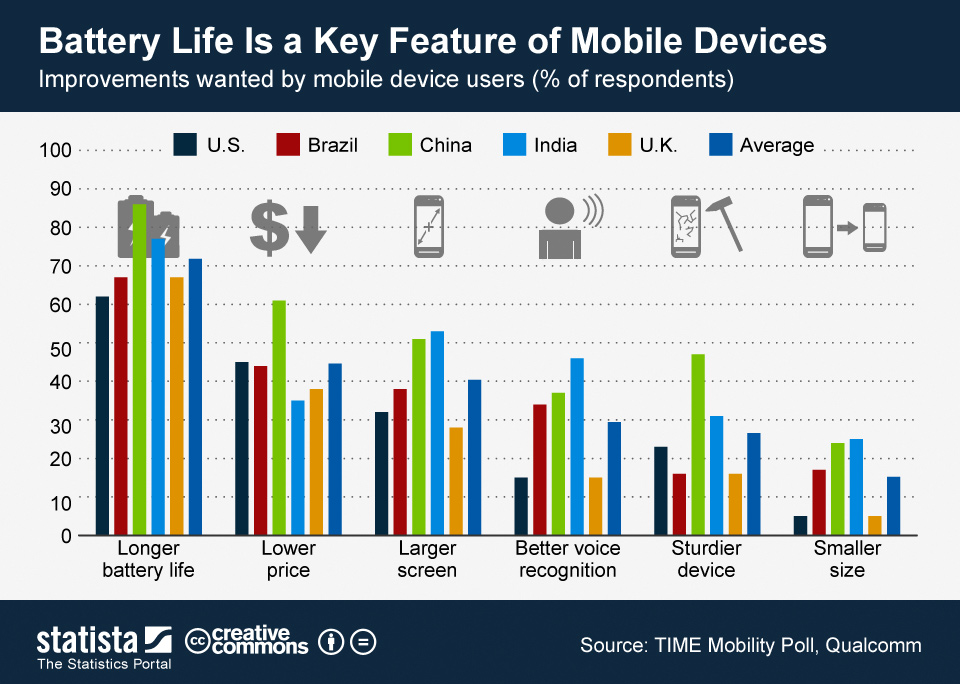
(Source: statista.com)
Battery Usage Patterns By Demographics
Age group
- 18-24 is the age group that uses mobile for 5-7 hours a day while charging it for 1-2 a day
- 25-34 is the professional and working age group that uses laptops for 4-5 hours a day and mobile phones for 2-3 hours a day, typically charging the device
- 35-54 is the age group of people using laptops more and mobile phones less comparatively. The laptop usage is 6-7 hours a day, and the use of a mobile is 2-3 hours while charging the devices for 10 hours for a laptop and a single charge of a phone.e
- The 55+ age group people use e-readers, mobiles, and tablets for 3-4 hours a day and charge the device in 2-3 days
Gender
- The male usage of devices is mostly laptops and phones because of streaming, games, and other things. The use of devices is 4-6 hours and 4-5 hours of charging because all these are high-end devices.
- The female usage spectrum consists mostly of mobile phones, which are used for 6-8 hours daily and charged daily.
Urban vs rural
- The battery industry in India, worth Rs. 1700 cr. and with a market share of 2000 million units, is dominated by dry carbon cell batteries. Rural areas largely demand them.
- Fifty-two thousand two hundred ninety people in rural areas use mobile phones, and there are other battery devices.
- Finally, in terms of single applications, we note that individuals in rural areas use social media such as Facebook (+17.8 %) and Snapchat (+22.5) more. In contrast, urban individuals spend a larger fraction of time on Instagram (+14.3 %) and Twitter (+24.2 %).
- The urban usage of batteries is in terms of energy production, with 45.8% of power produced.
- China is the largest manufacturer of lithium batteries, with 65% of the market dominated by it. It focuses on the production of EV vehicles.
Regional breakdown
- As EV sales continue to increase in today’s major markets in China, Europe, and the United States and expand across more countries, demand for EV batteries will also grow quickly.
- As EV sales continue to increase in today’s major markets in China, Europe, and the United States and expand across more countries, demand for EV batteries will also grow quickly.
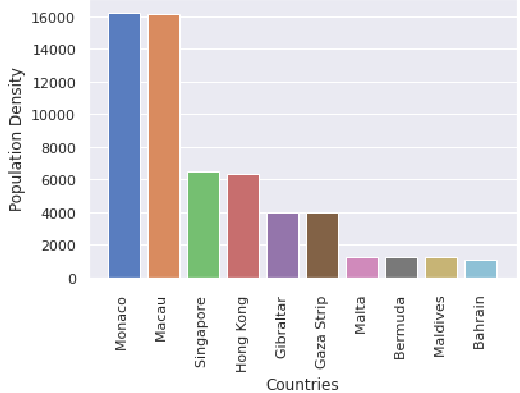
(Source: researchgate.net)
Future Trends In Battery Usage
The battery market is undergoing rapid growth and significant innovation, largely driven by the increasing global demand for energy storage solutions. In alignment with the Net Zero Scenario, grid-scale battery storage capacity is projected to expand dramatically—by 35 times—between 2022 and 2028, reaching nearly 950 GW. By 2030, an additional 190 GW of capacity is expected to be added, a substantial increase from just 11 GW in 2022.
The global market for future batteries, valued at 16 million units in 2024, is anticipated to grow to 62 million units by 2035. This represents a compound annual growth rate (CAGR) of 12.7% during the forecast period of 2024-2035.
Rising Demand for Critical Metals:
The growing demand for electric vehicle (EV) batteries is the primary driver behind the increased need for critical metals, particularly lithium. In 2023, the battery industry’s demand for lithium reached approximately 140 kilotons (kt), accounting for 85% of total global lithium demand—an increase of more than 30% compared to 2022. Similarly, demand for cobalt in battery production grew by 15%, reaching 150 kt, which represents 70% of total cobalt demand.
Impact on Mineral Supply and Costs:
In 2023, the supply of critical minerals such as cobalt, nickel, and lithium exceeded demand by 6.5%, 8%, and over 10%, respectively. This surplus in supply helped reduce the prices of these critical minerals, which in turn led to a decrease in overall battery costs.
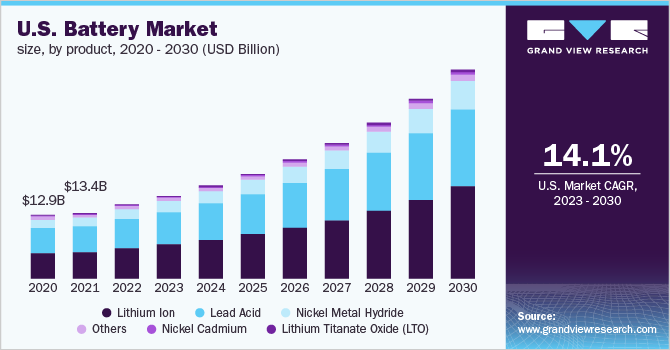
(Source: grandviewresearch.com)
Lead-Acid Battery Statistics
- The lead-acid battery market is growing steadily, with an annual growth rate of 6.9% expected from 2022 to 2032.
- By 2032, the market revenue for lead-acid batteries is projected to reach USD 59.0 billion.
- Lead-acid batteries are widely used due to their reliability and have a recycling rate of over 97%, making them environmentally friendly.

- These batteries have a nominal voltage of 2.0V per cell. When six cells are connected, they provide a total of 12.0V.
- The demand for lead-acid batteries is expected to rise to 476 GWh by 2025, driven by their increasing use in electric vehicles.
- Charging lead-acid batteries takes 8 to 10 hours, often done overnight for safety.
- Manufacturers claim these batteries can last between 400 to 550 charging cycles.
- They have a specific energy range of 35 to 40 Wh/kg and an energy density of 80 to 90 Wh/L, showing their capacity to store energy efficiently.
- Lead-acid batteries deliver a specific power of around 180 W/kg, providing consistent power when needed.
- The efficiency of charging and discharging these batteries varies from 50% to 95%, depending on design and usage.
- They offer a cost-effective energy-to-consumer-price ratio of 7 to 18 Wh/US$, depending on the battery type.
- Lead-acid batteries have a self-discharge rate of 3% to 20% per month, requiring periodic recharging.
- These batteries typically last for fewer than 350 cycles, making them more suitable for applications that don’t require frequent deep cycling.
- The nominal voltage for each cell is 2.1V, ensuring compatibility with various systems.
- They can be charged in temperatures ranging from –35°C to 45°C, making them suitable for different environments.
- Lead-acid batteries contribute minimally to landfill waste, with only 60,000 tons discarded, representing less than 0.1% of municipal solid waste. This is partly due to regulations in 41 states that prohibit landfill disposal.
Conclusion
Battery usage statistics show that the world revolves around devices; people nowadays are very fond of new devices and gadgets that run on batteries. As China became the biggest provider of lithium batteries, with 45% of the world’s cap, they are investing in EVS, which is going to be the next big thing in the automotive industry.
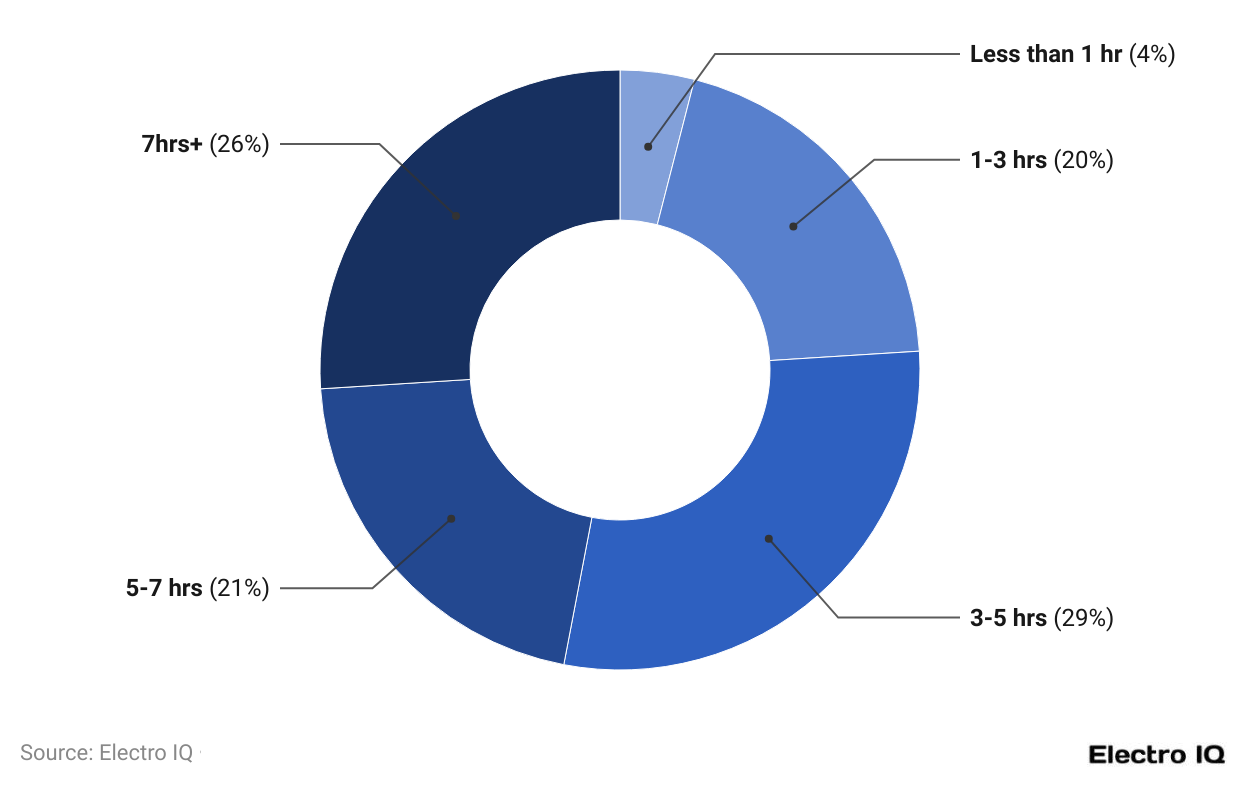
Different devices have different capacities. As mentioned above, a gaming laptop needs two times a charge and lasts for 6-7 hours where, whereas a notebook, which is comparatively lighter and used by professionals, lasts for 10 hours a day with a single charge. Other than that, some wearables perform very well in terms of battery life. Companies have also used advanced technologies for good battery life, and in the future, this will increase by 45% in the global market. The coming market understands the psychology of battery usage.
FAQ.
A battery typically makes up around 45% of a new EV’s price. How that battery is treated is key.
In 2023, the market size for batteries in India was around 1.5 billion U.S. dollars. It was estimated that in t030, the market will reach six billion dollars.
In 2023 alone, battery deployment in the powerhouse sector increased by more than 120 % year over year, adding 45 gigawatts to electricity systems around the globe.
In fact, 27% of Gen Z respondents claimed that phone overuse had become a problem in their lives. And 45% of Gen Zers claim to be immediately taking steps towards reducing their screen time.

Aruna Madrekar is an editor at Smartphone Thoughts, specializing in SEO and content creation. She excels at writing and editing articles that are both helpful and engaging for readers. Aruna is also skilled in creating charts and graphs to make complex information easier to understand. Her contributions help Smartphone Thoughts reach a wide audience, providing valuable insights on smartphone reviews and app-related statistics.






